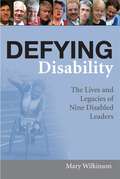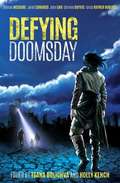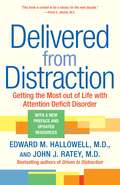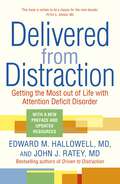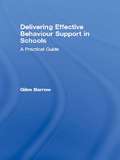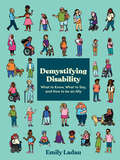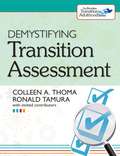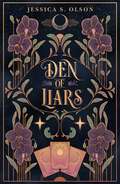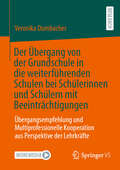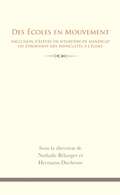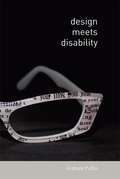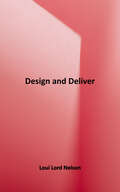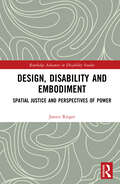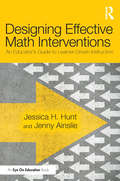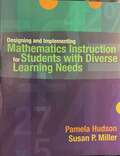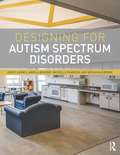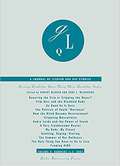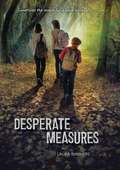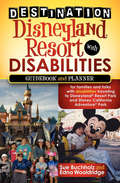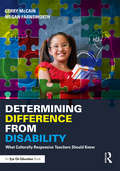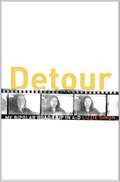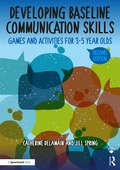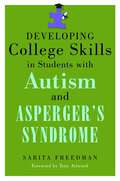- Table View
- List View
Defying Disability: The Lives and Legacies of Nine Disabled Leaders
by Mary WilkinsonThis book tells the stories of nine disabled leaders who, by force of personality and concrete achievement, have made us think differently about disability. Whatever direction they have come from, they share a common will to change society so that disabled people get a fair deal. There are compelling biographies of: · Sir Bert Massie: public servant · Lord (Jack) Ashley: Labour politician · Rachel Hurst: activist and campaigner · Tom Shakespeare: academic · Phil Friend: entrepreneur and business consultant · Peter White: broadcaster · Mat Fraser: actor, musician and performer · Andrew Lee: activist and campaigner · Dame Tanni Grey-Thompson: Paralympic champion Defying Disability is based on extensive interviews with the subjects and the people who know them. It marks their similarities and differences, the forces that drove them to achieve, the impact they have had on policies and practice, and how the modern history of disability in the UK has been played out in their lives. Defying Disability is not just a good read; it will inform professionals in the field, students in disability studies, disabled people, their families and carers, and everyone interested in disability politics and policies.
Defying Doomsday
by Tsana Dolichva Holly KenchTeens form an all-girl band in the face of an impending comet. A woman faces giant spiders to collect silk and protect her family. New friends take their radio show on the road in search of plague survivors. A man seeks love in a fading world. How would you survive the apocalypse? Defying Doomsday is an anthology of apocalypse fiction featuring disabled and chronically ill protagonists, proving it’s not always the “fittest” who survive - it’s the most tenacious, stubborn, enduring and innovative characters who have the best chance of adapting when everything is lost. In stories of fear, hope and survival, this anthology gives new perspectives on the end of the world, from authors Corinne Duyvis, Janet Edwards, Seanan McGuire, Tansy Rayner Roberts, Stephanie Gunn, Elinor Caiman Sands, Rivqa Rafael, Bogi Takács, John Chu, Maree Kimberley, Octavia Cade, Lauren E Mitchell, Thoraiya Dyer, Samantha Rich, and K Evangelista.
Deliverance from Jericho: Six Years in a Blind School
by Bruce Atchison<P>Imagine being a disabled child, hastily sent to a boarding school hundreds of miles from home, and being kept there for months at a time. This was the fate of most physically and mentally impaired students half a century ago. Intellectuals and government officials once believed that the best way to educate “handicapped youngsters” was to segregate them from the able-bodied population, concentrating those pupils into large institutions. <P>Deliverance from Jericho: Six Years in a Blind School is the story of Bruce Atchison, one such child. Shuttled between a dysfunctional family and an uncaring asylum, his feelings and experiences are related here in a candid fashion. Through his partially-sighted eyes, readers are given a glimpse beyond the manicured lawns and impressive facades into the daily life of Jericho Hill School for the Deaf and Blind. <P>The author describes how he and his classmates learned Braille, used an abacus for arithmetic, and played sports, educational aspects which are not generally known to the public. Apart from those differences, school life was basically the same as in other institutes. Jericho had its bullies, its cliques, its out-of-touch administrators, and its deplorable food.
Delivered from Distraction
by Edward M. Hallowell John J. RateyIn 1994, Driven to Distraction sparked a revolution in our understanding of attention deficit disorder. Widely recognized as the classic in the field, the book has sold more than a million copies. Now a second revolution is under way in the approach to ADD, and the news is great. Drug therapies, our understanding of the role of diet and exercise, even the way we define the disorder-all are changing radically. And doctors are realizing that millions of adults suffer from this condition, though the vast majority of them remain undiagnosed and untreated. In this new book, Drs. Edward M. Hallowell and John J. Ratey build on the breakthroughs of Driven to Distraction to offer a comprehensive and entirely up-to-date guide to living a successful life with ADD. As Hallowell and Ratey point out, "attention deficit disorder" is a highly misleading description of an intriguing kind of mind. Original, charismatic, energetic, often brilliant, people with ADD have extraordinary talents and gifts embedded in their highly charged but easily distracted minds. Tailored expressly to ADD learning styles and attention spans, Delivered from Distraction provides accessible, engaging discussions of every aspect of the condition, from diagnosis to finding the proper treatment regime. Inside you'll discover* whether ADD runs in families* new diagnostic procedures, tests, and evaluations* the links between ADD and other conditions* how people with ADD can free up their inner talents and strengths* the new drugs and how they work, and why they're not for everyone* exciting advances in nonpharmaceutical therapies, including changes in diet, exercise, and lifestyle* how to adapt the classic twelve-step program to treat ADD* sexual problems associated with ADD and how to resolve them* strategies for dealing with procrastination, clutter, and chronic forgetfulness ADD is a trait, a way of living in the world. It only becomes a disorder when it impairs your life. Featuring gripping profiles of patients with ADD who have triumphed, Delivered from Distraction is a wise, loving guide to releasing the positive energy that all people with ADD hold inside. If you have ADD or care about someone who does, this is the book you must read. From the Hardcover edition.
Delivered from Distraction: Getting the Most out of Life with Attention Deficit Disorder
by Edward M. Hallowell John J. Ratey'If you read only one book about attention deficit disorder, it should be Delivered from Distraction.' Michael Thompson, Ph.D., New York Times bestselling co-author of Raising CainIn 1994, Driven to Distraction sparked a revolution in our understanding of attention deficit disorder. Widely recognized as the classic in the field, the book has sold more than a million copies. Now a second revolution is under way in the approach to ADD, and the news is great. Drug therapies, our understanding of the role of diet and exercise, even the way we define the disorder - all are changing radically. And doctors are realizing that millions of adults suffer from this condition, though the vast majority of them remain undiagnosed and untreated. In this new book, Drs Edward M. Hallowell and John J. Ratey build on the breakthroughs of Driven to Distraction to offer a comprehensive and entirely up-to-date guide to living a successful life with ADD.As Hallowell and Ratey point out, 'attention deficit disorder' is a highly misleading description of an intriguing kind of mind. Original, charismatic, energetic, often brilliant, people with ADD have extraordinary talents and gifts embedded in their highly charged but easily distracted minds. Tailored expressly to ADD learning styles and attention spans, Delivered from Distraction provides accessible, engaging discussions of every aspect of the condition, from diagnosis to finding the proper treatment regime. Inside you'll discover:- whether ADD runs in families- new diagnostic procedures, tests, and evaluations- the links between ADD and other conditions- how people with ADD can free up their inner talents and strengths- the new drugs and how they work, and why they're not for everyone- exciting advances in nonpharmaceutical therapies, including changes in diet, exercise, and lifestyle- how to adapt the classic twelve-step program to treat ADD- sexual problems associated with ADD and how to resolve them- strategies for dealing with procrastination, clutter, and chronic forgetfulnessADD is a trait, a way of living in the world. It only becomes a disorder when it impairs your life. Featuring gripping profiles of patients with ADD who have triumphed, Delivered from Distraction is a wise, loving guide to releasing the positive energy that all people with ADD hold inside. If you have ADD or care about someone who does, this is the book you must read.
Delivering Effective Behaviour Support in Schools: A Practical Guide
by Giles BarrowThis book is intended to help schools become increasingly inclusive. The advice and guidance is aimed at managers and practitioners providing behavior support, either through an LEA service, by outreach work from specialist centers or via on-site provision. You will find advice on developing effective support; planning, monitoring and evaluating support; working in partnership with colleagues in schools and other services; identifying resources to maximize behavior support interventions; and providing support staff with proven techniques for improving service delivery. There are lots of practical resources for implementing suggested strategies, examples of proformas and spreadsheet formats and other useful planning materials relating to behavior support. Managers of behavior support services should find this book particularly helpful, as will those staff providing behavior support from PRUs (Pupil Referral Units), on-site units and special schools. There will also be aspects of the book that will appeal to mentors and staff with pastoral responsibilities in mainstream schools.
Demystifying Disability: What to Know, What to Say, and How to Be an Ally
by Emily LadauAn approachable guide to being a thoughtful, informed ally to disabled people, with actionable steps for what to say and do (and what not to do) and how you can help make the world a more inclusive place ONE OF THE BEST BOOKS OF THE YEAR: NPR, Booklist • &“A candid, accessible cheat sheet for anyone who wants to thoughtfully join the conversation . . . Emily makes the intimidating approachable and the complicated clear.&”—Rebekah Taussig, author of Sitting Pretty: The View from My Ordinary, Resilient, Disabled Body People with disabilities are the world&’s largest minority, an estimated 15 percent of the global population. But many of us—disabled and nondisabled alike—don&’t know how to act, what to say, or how to be an ally to the disability community. What are the appropriate ways to think, talk, and ask about disability? Demystifying Disability is a friendly handbook on the important disability issues you need to know about, including:• Recognizing and avoiding ableism (discrimination toward disabled people)• Practicing good disability etiquette• Ensuring accessibility becomes your standard practice, from everyday communication to planning special events• Appreciating disability history and identity• Identifying and speaking up about disability stereotypes in media Authored by celebrated disability rights advocate, speaker, and writer Emily Ladau, this practical, intersectional guide offers all readers a welcoming place to understand disability as part of the human experience.Praise for Demystifying Disability&“Whether you have a disability, or you are non-disabled, Demystifying Disability is a MUST READ. Emily Ladau is a wise spirit who thinks deeply and writes exquisitely.&”—Judy Heumann, international disability rights advocate and author of Being Heumann &“Emily Ladau has done her homework, and Demystifying Disability is her candid, accessible cheat sheet for anyone who wants to thoughtfully join the conversation. A teacher who makes you forget you&’re learning, Emily makes the intimidating approachable and the complicated clear. This book is a generous and needed gift.&”—Rebekah Taussig, author of Sitting Pretty: The View from My Ordinary Resilient Disabled Body
Demystifying Transition Assessment (The Brookes Transition to Adulthood Series)
by Ronald Tamura Colleen Thoma<p>Assessment is the cornerstone of every good transition plan. Now there's a book that demystifies the what, when, why, and how of collecting transition assessment data-and using the results to help students with disabilities prepare for adulthood. <p>Developed by two respected transition authorities, this practical guide prepares education professionals to use today's best assessment tools and strategies to identify which transition approaches really work. You'll discover how to <p> <li>choose assessments appropriate for each situation and student <li>apply best assessment practices in 7 key areas (see sidebar) <li>collect the right data at the right time <li>implement evidence-based practices that meet IDEA requirements for transition assessment <li>make the most of informal assessments and formal performance-based methods tailored to each student's needs <li>translate assessment results into better, more personalized transition IEP plans</li> <p> <p>To help you find the assessment tools that best meet your needs, the book includes an invaluable quick-reference guide to more than 90 transition assessments and which areas they assess. You'll also follow case studies of a teacher and two students as they navigate the transition assessment process, and you'll get sample forms for assessing student skills and goals, enhancing transition IEPs, helping students plan for college and employment, and much more. <p>Essential for every transition specialist and educator, this book will be your trusted companion as you make sound decisions about assessment; ensure individualized, person-centered transition plans; and support students' post-school goals and dreams.</p>
Den of Liars (The Devious)
by Jessica S. OlsonA young thief attempting a daring casino heist during a high-stakes tournament is torn between two warring brothers in Den of Liars, a thrilling YA fantasy romance by acclaimed author Jessica S. Olson.Lola St. James is the world’s best kept secret. When her father’s loss in the Liar’s Dice Tournament—a high-stakes competition where players are forced to gamble with their deepest secrets—made her a target, she was rescued by the Thief, the notorious leader of the Tentacles. But the Thief’s kindness came with a price: Lola’s heart. In the years that followed, she and the Thief formed a bond like no other, able to feel each other’s emotions because of their shared heart.Now, living under the pseudonym Astra, she is determined to prove herself and become a full-fledged Tentacle. But when a critical heist goes sideways, the only way forward is for Lola to compete in the Liar’s Dice Tournament herself. Lola is confident in her ability to pull off any heist, but the Thief's mysterious brother, the Liar, runs the game and he turns out to be more than she bargained for. As her attraction for him grows and illusions run wild, she will be forced to confront the secrets of her past, the truth of the brothers’ shared history, and the lies she tells herself.
Der Übergang von der Grundschule in die weiterführenden Schulen bei Schülerinnen und Schülern mit Beeinträchtigungen: Übergangsempfehlung und Multiprofessionelle Kooperation aus Perspektive der Lehrkräfte
by Veronika DumbacherDer Übergang von der Grundschule in die weiterführenden Schulen ist eine frühe Weichenstellung im Bildungssystem, die für Kinder mit Beeinträchtigungen bedeutende Selektionsrisiken birgt. Die vorliegende qualitative Studie nimmt den Übergang ins Sekundarschulwesen bei Lernenden mit Beeinträchtigungen daher näher in den Blick. Dabei stehen zwei zentrale Aufgaben der Grundschullehrkraft im Mittelpunkt: die Übergangsempfehlung sowie die Multiprofessionelle Kooperation. Die Ergebnisse zur Übergangsempfehlung zeigen, dass die Lehrpersonen neben leistungsbezogenen Kriterien (z. B. Noten) zahlreiche weitere Merkmale in die Empfehlung einbeziehen (z. B. Merkmale der weiterführenden Schule; medizinisch-therapeutische Aspekte). Die Befunde zur Multiprofessionellen Kooperation verdeutlichen, dass die Grundschullehrkräfte die Lehrkraft für Sonderpädagogik als zentrale Kooperationspartnerin benennen. Der Hauptgrund für Kooperation beim Übergang besteht in der Erweiterung der eigenen Wissensbasis, wobei der Austausch als die am häufigsten praktizierte Form der Kooperation angeführt wird. In einer sich anschließenden Typenbildung lassen sich Gemeinsamkeiten und Unterschiede im Empfehlungs- und Kooperationsverhalten der Lehrkräfte identifizieren.
Des Ecoles en mouvement
by Hermann Duchesne Nathalie BelangerFaire de la diversité une force constructive qui contribue à la compréhension mutuelle entre individus et entre groupes constitue actuellement un discours central des sociétés occidentales. En éducation, ce discours est repérable dans la pratique inclusive. Ce mouvement en faveur de l'inclusion de tous les élèves, quels que soient leurs attributs individuels ou caractéristiques personnelles, épouse cependant différents contours, génère différentes significations selon les contextes où il prend racine et évolue. Cet ouvrage examine la mise en oeuvre de ces discours en pratique. Les auteurs présentent, à partir d'une approche qualitative et d'outils d'enquête communs, des « écoles en mouvement », des écoles qui se veulent inclusives au Canada, en France, en Grande-Bretagne et en Italie, présentant une diversité de situations et d'exemples tirés de ces contextes divers. Cet ouvrage diffère des manuels qui présentent généralement ce que l'on doit faire et opte pour une investigation empirique qui permet de regarder ce que veut concrètement dire l'inclusion en milieu scolaire.
Des Écoles en mouvement: Inclusion d'élèves en situation de handicap ou éprouvant des difficultés à l'école (Éducation)
by Bélanger, Nathalie; Duchesne, HermannLes auteurs présentent, à partir d’une approche qualitative et d’outils d’enquête communs, des « écoles en mouvement », des écoles qui se veulent inclusives au Canada, en France, en Grande-Bretagne et en Italie, présentant une diversité de situations et d’exemples tirés de ces contextes divers. Faire de la diversité une force constructive qui contribue à la compréhension mutuelle entre individus et entre groupes constitue actuellement un discours central des sociétés occidentales. En éducation, ce discours est repérable dans la pratique inclusive. Ce mouvement en faveur de l’inclusion de tous les élèves, quels que soient leurs attributs individuels ou caractéristiques personnelles, épouse cependant différents contours, génère différentes significations selon les contextes où il prend racine et évolue. Cet ouvrage examine la mise en œuvre de ces discours en pratique. Les auteurs présentent, à partir d’une approche qualitative et d’outils d’enquête communs, des « écoles en mouvement », des écoles qui se veulent inclusives au Canada, en France, en Grande-Bretagne et en Italie, présentant une diversité de situations et d’exemples tirés de ces contextes divers. Cet ouvrage diffère des manuels qui présentent généralement ce que l’on doit faire et opte pour une investigation empirique qui permet de regarder ce que veut concrètement dire l’inclusion en milieu scolaire. Publié en français
Design Meets Disability
by Graham PullinEyeglasses have been transformed from medical necessity to fashion accessory. This revolution has come about through embracing the design culture of the fashion industry. Why shouldn't design sensibilities also be applied to hearing aids, prosthetic limbs, and communication aids? In return, disability can provoke radical new directions in mainstream design. Charles and Ray Eames's iconic furniture was inspired by a molded plywood leg splint that they designed for injured and disabled servicemen. Designers today could be similarly inspired by disability. In Design Meets Disability, Graham Pullin shows us how design and disability can inspire each other. In the Eameses' work there was a healthy tension between cut-to-the-chase problem solving and more playful explorations. Pullin offers examples of how design can meet disability today. Why, he asks, shouldn't hearing aids be as fashionable as eyewear? What new forms of braille signage might proliferate if designers kept both sighted and visually impaired people in mind? Can simple designs avoid the need for complicated accessibility features? Can such emerging design methods as "experience prototyping" and "critical design" complement clinical trials? Pullin also presents a series of interviews with leading designers about specific disability design projects, including stepstools for people with restricted growth, prosthetic legs (and whether they can be both honest and beautifully designed), and text-to-speech technology with tone of voice. When design meets disability, the diversity of complementary, even contradictory, approaches can enrich each field.
Design and Deliver: Planning and Teaching Using Universal Design for Learning
by Loui Lord NelsonUniversal Design for Learning (UDL) is the best way to teach all students effectively and break down barriers to learning―but how can busy teachers get started with UDL right now? Find the answers in the second edition of this bestselling, teacher-trusted primer, created by internationally recognized UDL expert Loui Lord Nelson. Thoroughly updated to reflect new research and developments in the field of UDL, this book gives K–12 teachers a reader-friendly UDL introduction and a practical framework for implementation, with guidelines and checkpoints for designing effective, barrier-free lesson plans and learning environments. You’ll learn how to use the three core principles of UDL―Engagement, Representation, and Action and expression―to present information in multiple ways and ensure access for all learners. Throughout the book, detailed examples, stories, illustrations, teacher reflections, and activities reinforce UDL principles and help you put them into practice in both virtual and in-person settings. Written in first person, like a face-to-face talk with a passionate educator, this research-based book will guide you in designing equitable, inclusive, and culturally responsive learning environments that meet the needs of diverse learners. An essential UDL introduction for both preservice and inservice educators! WHAT’S NEW: - Key insights from the latest neuroscience research - Useful stories and practical tips from teachers implementing UDL - Technology bytes: timely tips and ideas on how to enhance online learning with UDL - Expert guidance on current topics, including culturally responsive teaching, urban education, and a focus on the expert learner - “Ponder this” prompts throughout the book to help readers consider new ideas and discover additional resources - End-of-chapter “check-ins” that help readers apply what they’ve learned - ONLINE MATERIALS: Designing instruction with UDL is easier than ever with these online resources, available as printable downloads: CAST UDL Guidelines; an Identifying Your Resources chart; a UDL design cycle graphic; a UDL lesson plan flowchart; and classroom resource mapping charts for elementary, middle, and high school teachers.
Design, Disability and Embodiment: Spatial Justice and Perspectives of Power (Routledge Advances in Disability Studies)
by Janice RiegerThis timely book explores the spatial and social injustices within our streets, malls, schools, and public institutions. Taken-for-granted acts like going for a walk, seeing an exhibition with a friend, and going to school are, for people with disabilities, conditional or precluded acts due to exclusion by design. This book stimulates debate and discussion about current practice and studies in spatial design in the context of disability and the growing need for inclusive design globally. Case studies of inclusive design in spaces like museums, malls, galleries and universities are presented to challenge and expose the perspectives of power and spatial injustices that still exist within these spaces today. The international case studies presented purposely privilege the voices and perspectives of people with disabilities, to expose the multisensorial perspectives of spatial justice in order to understand inclusion more holistically through embodiment. If you are an architect, designer, arts educator, curator or museum professional or just want a world where spatial justice is possible, then this book will provide you with a new perspective of spatial design through critical disability studies, allyship and codesign, where tangible approaches and practices for inclusive design are explored.
Designing Effective Math Interventions: An Educator's Guide to Learner-Driven Instruction
by Jessica H. Hunt Jenny AinslieDesign effective, learner-driven math interventions with this accessible and thought-provoking guidebook. Learn how to set up instruction to promote participation and understanding, plan purposeful, targeted tasks, develop student thinking, and create tools to assess student work in a way that measures learning, not just performance. Chapters explore questions that educators frequently struggle with when designing interventions, offering user-friendly research and evidence-based strategies to help overcome common hurdles. This book is essential reading for anyone seeking an adaptive approach to Tier 2 and 3 interventions that positions struggling students as competent learners.
Designing and Implementing Mathematics Instruction for Students with Diverse Learning Needs
by Susan Miller Pamela HudsonThis exciting new book integrates the explicit teaching practices that have proven effective for students with disabilities with the NCTM math standards that dominant current mathematics practices in the United States . <p><p>In Part 1 of the book, teachers learn the fundamentals of mathematics assessment and instructional design for conceptual, declarative knowledge, procedural, and problem-solving lessons. In Part 2, the detailed scope and sequence charts, along with instructional guidelines keyed to the objectives, provide teachers with specific guidelines for assessment and design. <p><p>The curriculum-based assessment chapter (Ch. 2) helps teachers group students for instruction, place in curriculum, monitor performance, and make data based decisions. Content coverage of all five NCTM content standards provides teachers the support needed to access the general education curriculum and help their students meet annual yearly progress expectations (Chapters 7 ― 15). Detailed scope and sequence charts provide a valuable resource for assessing, planning, and designing instruction (Chapters 7-15). Instructional design discussion includes four domains: concepts, declarative knowledge, problem solving, and procedural knowledge. When teachers understand the function of the instruction, their effectiveness and efficiency are enhanced (Chapters 3-15). Integration of explicit teaching practices with NCTM approach helps teachers maintain practices that work for students with diverse needs while integrating reformed-based mathematics practices (in Chapters 1, 7-15). Detailed guidelines, including scripted lessons, on HOW to design and deliver effective instruction. These sample lessons illustrate how to apply the explicit teaching sequence to various content areas and provide examples for preservice and inservice teachers to use when developing their own lessons.
Designing for Autism Spectrum Disorders
by Angela Bourne Michelle Pearson Kristi Gaines Mesha KleibrinkWinner of the 2017 IDEC Book Award, 2017 EDRA Great Places Award (Book Category), 2017 American Society of Interior Designers Joel Polsky Prize and the 2016 International Interior Design Association TXOK Research Award Designing for Autism Spectrum Disorders explains the influence of the natural and man-made environment on individuals with autism spectrum disorders (ASD) and other forms of intellectual/developmental disabilities (IDD). Drawing on the latest research in the fields of environmental psychology and education, the authors show you how architecture and interior spaces can positively influence individuals with neurodiversities by modifying factors such as color, lighting, space organization, textures, acoustics, and ventilation. Now you can design homes, therapeutic environments, work environments, and outdoor spaces to encourage growth and learning for the projected 500,000 children with ASD (in the United States alone) who are expected to reach adulthood by 2024. Topics discussed include:-Environmental design theories-Symptoms of ASD-Sensory processing deficits -Design needs of individuals on the spectrum at all ages-Design methods and solutions for spaces, including residential, learning, work, and therapeutic environments encompassing a wide range of budgets-Designing for self-actualization, well-being, and a high quality of life for the duration of an individual's life-Avenues for healthy living and aging in place-Biophilic design-Environmental impact on well-being -Strategies to promote active living as an integral part of the welfare focus.
Desiring Disability: Queer Theory Meets Disability Studies
by Ellen Samuels Robert McRuer Abby L. WilkersonIn multiple locations, activists and scholars are mapping the intersections of queer theory and disability studies, moving issues of embodiment and desire to the center of cultural and political analyses. The two fields are premised on the idea that the categories of heterosexual/homosexual and able-bodied/disabled are historically and socially constructed. Desiring Disability: Queer Theory Meets Disability Studies explores how the frameworks for queer theory and disability studies suggest new possibilities for one another, for other identity-based frameworks of activism and scholarship, and for cultural studies in general. <P><P> Topics include the study of "crip theory" and queer/disabled performance artists; the historical emergence of normalcy and parallel notions of military fitness that require both the production and the containment of queerness and disability; and butch identity, transgressive sexual practices, and rheumatoid arthritis. <P><P> Contributors. Sarah E. Chinn, Eli Clare, Naomi Finkelstein, Catherine Lord, Cris Mayo, Robert McRuer, Todd Ramlow, Jo Rendell, Ellen Samuels, Carrie Sandahl, David Serlin, Patrick White
Desperate Measures
by Laura SummersThe idea for Desperate Measures came from the observation there were very few protagonists with learning disabilities in children's books and the reality that one of her own children is disabled. The result is the creation of Rhianna and her sister Vicky: two very individual teenagers, one of whom happens to have learning disabilities. Laura now lives in North Devon with her husband and children and when not writing loves to draw and paint.
Destination Disneyland Resort with Disabilities: Guidebook and Planner
by Sue Buchholz Edna Wooldridge&“While the focus is how to maneuver Disneyland, the larger message is about maneuvering life—and not leaving anyone behind. This is one beautiful book.&” —Judith Sherven, PhD and Jim Sniechowski, PhD, bestselling authors of Living Your Love Every Day Destination Disneyland Resort with Disabilities is a guidebook that will assist people with disabilities to enjoy their experience to the fullest at Disneyland Resort. Families of children who have disabilities, adults who have disabilities, caregivers, travel agents, and tour guides will all benefit from the information in this guidebook. This is the only Disneyland Resort book written on this topic. This book includes planning your trip ahead of time, detailed packing lists with special needs in mind, traveling to California, places to stay, transportation around the Anaheim area, Disney amenities, special needs accommodations for every attraction, and a special section for families with children who have autism or sensory processing disorders. &“Thanks for writing such a great book. You have done an excellent job! The details are amazing. Congratulations on a great resource! I learned many things I did not know.&” —Sandy Silveria, proprietor, We&’re Outta Here Travel
Determining Difference from Disability: What Culturally Responsive Teachers Should Know
by Gerry McCain Megan FarnsworthThis essential book offers clear guidelines for determining if the Culturally Linguistically Diverse (CLD) students / English Language Learners (ELL) in your general education classroom are experiencing typical language differences, learning disabilities, or both. By combining helpful case-studies with insightful research, the authors provide a framework for differentiating instruction that uses culturally appropriate interventions to build upon student strengths while creating a foundation for further learning and achievement. You will discover how to: Connect your own and your students’ cultural assets to classroom content; Review language acquisition stages and design corresponding instruction; Collaborate with peers and discuss the realities of reaching out for support and problem solving; Choose effective and appropriate instructional strategies based on documentation of data through progress monitoring; Move from a traditional behavioristic perspective to a more culturally responsive perspective; Identify patterns in formal assessments and informal instruction in order to distinguish between language differences and learning disabilities. In addition, the book includes a number of activities and graphs that can be implemented immediately in any classroom. Many of these materials can be downloaded for free from the book’s product page: www.routledge.com/9781138577756.
Detour: My Bipolar Road Trip in 4-D
by Lizzie SimonAfter being diagnosed with bipolar disorder, the author takes a road trip to meet others like herself
Developing Baseline Communication Skills: Games and Activities for 3-5 year olds (The Good Communication Pathway)
by Catherine Delamain Jill SpringDeveloping Baseline Communication Skills is a practical resource designed to fit with baseline assessments in primary school. The second edition of this bestselling resource contains a programme of games and activities to foster personal and social development, and promote language and literacy skills in 3–5 year olds. The book seeks to address language and communication difficulties for children coming into reception class by providing a range of fun and engaging activities. Suitable for whole classes or small groups of children, the activities focus on both personal, social, emotional development as well as language and literacy in areas such as body language, independence, turn taking, listening, speaking and auditory memory. Features include: 200 games and activities which are differentiated for different ages and levels of ability; A clear aim, equipment list and instructions for each activity; Photocopiable templates for ease of use; Supplementary resource sheets including pictures and scripts to use with the activities. Now fully revised and updated in line with current policy and legislation, this book is suitable for young children in any school setting including nurseries, playgroups and reception classes. It also includes material that may be used as an effective part of a speech and language therapy programme in consultation with a therapist. This is a unique manual that will be an essential addition to the materials used by professionals working with young children.
Developing College Skills in Students with Autism and Asperger's Syndrome
by Sarita FreedmanGoing to college can be a daunting prospect for any young person, but for teenagers on the autism spectrum this is especially true. This book describes the unique needs that ASD students entering further or higher education are likely to have. The author identifies the key skill-sets they will need to develop in order to be successful in college and in life, and shows how they can be helped to develop these. She outlines the skills required for success in further and higher education in relation to the strengths and weaknesses of individuals with ASDs, and explains how those weaknesses can be ameliorated to enable success at college. Describing the unique accommodations and support that students with ASD will need, and the skills for which they will need particular help, she provides effective intervention strategies that can be implemented throughout the period leading up to college entrance. This book is essential reading for psychologists, special educators, educational therapists, high school teachers/career counselors, and other professionals supporting high school and college students on the autism spectrum. Parents of such students will also benefit from the ideas presented in this book.
